Your Comprehensive Guide to Curling Irons
Do you know the difference between ceramic and tourmaline? Let us school you.
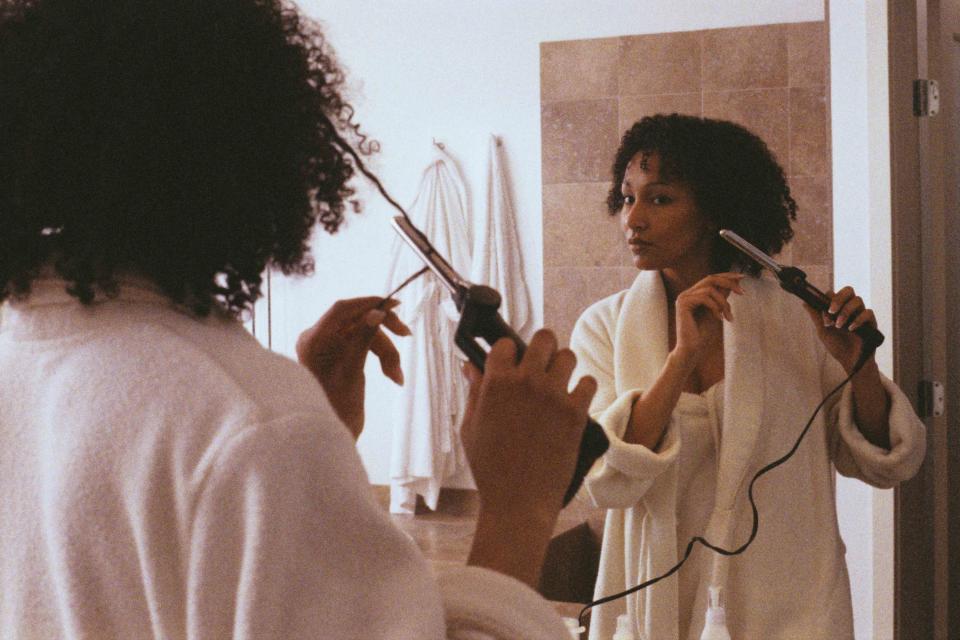
Getty Images
Chances are, you don’t spend time thinking about your curling iron.
And when we say this, we mean that you probably don't sit there and ponder what it’s made out of, the size, its clamp. Until, that is, you need to buy a new one.
In case you haven’t perused the curling iron aisle in a while, it’s expansive! And if you’re going the online shopping route, your options multiply all the more. So if you’re in the market for a new curling iron and want to get it right, don’t fret, because we tapped renowned hairstylist Dyana Nematalla, owner of Sirène and Tinte salons in Atlanta, to break it all down for us.
But before we deep dive into the specifics of curling irons, now seems like a good time to remind you of the fact that you should never use a curling iron (or any hot tool) on your hair without first applying some kind of heat protectant.
We're fans of Living Proof Perfect hair Day Heat Styling Spray, which is lightweight and silicone-free. It's a great option if you want to spray your hair right before you use the curling iron. We also love JVN's Complete Blowout Styling Milk. This product works on all hair types and helps you achieve a smooth blowout while protecting against heat.
:
Types of Curling Irons
Ceramic
T3 SinglePass Curl 1.25” Professional Ceramic Curling Iron
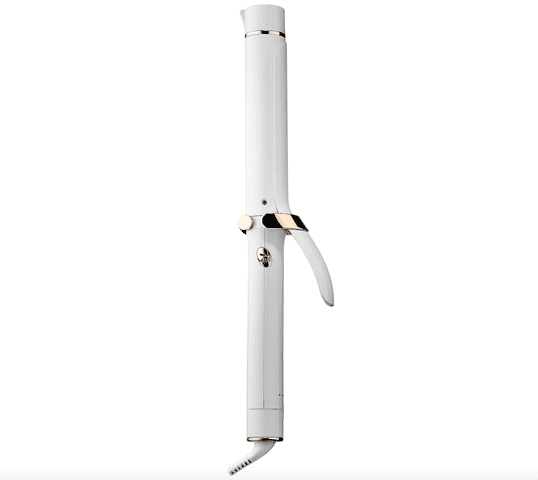
To shop: $170; sephora.com
Ceramic curling irons are the base line when it comes to at-home hair styling. They work well on all hair types, lengths, and are easy to use. You can find irons with a ceramic coating or ceramic plates, and since the coating can chip or wear off, full ceramic plates are usually the better option. Ceramic creates an infrared heat that penetrates deep into your hair to help lock in moisture and shine, and it’s also known to emit negative ions, which counteract the positive ions found in frizzy hair. It also provides a smoother surface, so you can easily glide the iron out of your hair while it’s still clamped to create the smooth, flat ends that are currently on-trend for many styles. All of that means less damage to hair.
Titanium
BaBylissPRO Nano Titanium Spring Curling Iron
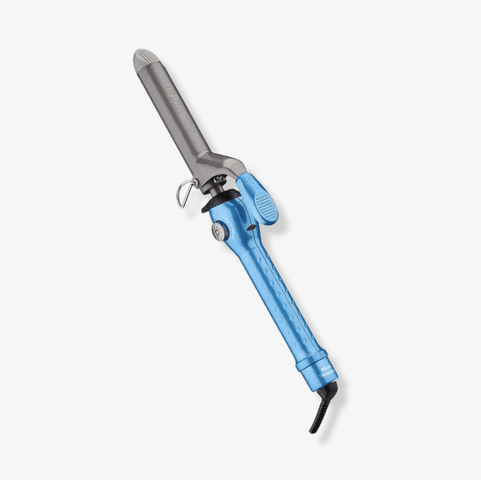
To shop: $48; ulta.com
Titanium is one of the strongest metals found in nature, and it gives you the hottest heat of all the options (which is why people often use a glove when using titanium irons). This makes it a great option for thick hair or hair resistant to curls. Professionals often turn to titanium, because they can count on the consistent heat a titanium iron can offer, but at-home users should be careful. “I love titanium for extremely thick, textured hair, and I use a titanium curling iron when I’m applying a keratin treatment,” explains Nematalla of her professional usage.
Gold-Plated
Hot Tools Professional Gold Curling Iron
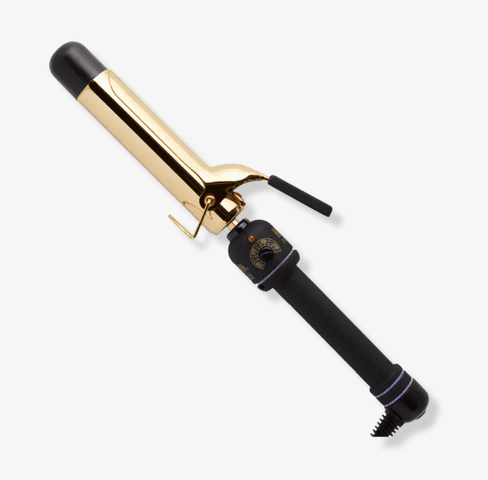
To shop: $55; ulta.com
Gold curling irons are the "OG of irons" according to Nematalla. They can tolerate extremely high heat for long periods of time and are best for thick or coarse hair. Often gold-plated curling irons are more budget-friendly than other options, but at-home users have to be careful with the level of heat it provides.
Tourmaline
CHI Ceramic Tourmaline 1" Curling Iron, Black
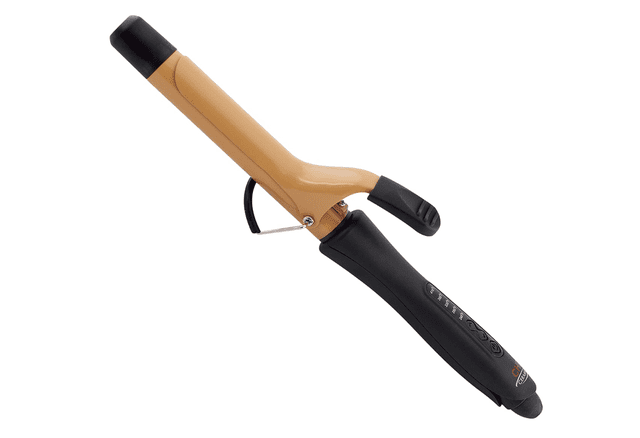
To shop: $47; amazon.com
Tourmaline is the newest of all the types of curling irons you can find on the market. Tourmaline is a semi-precious stone that is crushed up and used as a coating on the iron, and since tourmaline produces six times more negative ions than ceramic, it is even more gentle than ceramic options and can help reduce frizziness and prevent damage.
Curling Iron Size
The size curling iron you use directly dictates the type and size curl you’ll get.
¾” Barrel: Great for creating corkscrew curls or ringlets, or for people with tight curls to touch-up their natural curl. Not ideal for longer hair.
1” Barrel: This size is the most versatile and can work for all lengths and textures of hair.
1 ¼” Barrel: Use this size barrel to create volume at the root of shorter hair and on medium to long hair.
1 ½” Barrel: The larger barrel size makes it easier to curl longer hair, and this size is good for creating loose waves on medium to long hair. You can use this size iron on short hair to help achieve that big, '90s bob blow-out.
Styling Options
Cone
Cone-shaped or tapered wands have a wider base and more narrow tip and are great for getting a tousled, beachy wave. “I love using them to create 'S' waves for an old Hollywood look, and they are quite user-friendly,” says Nematalla. “If you wrap your hair on it vertically, it gives you a fool proof beachy wave.”
Clampless/Wand
Curling wands were all the rage a few years ago, and while some of that furor has died down, they are still a useful tool. “Anyone who is a little challenged with a curling iron and gets clamp marks will do well with a wand,” Nematalla shares. And since you wrap the hair around the barrel manually and hold the ends, they are a great option for people with dry, damaged ends who want curl, but need to avoid heat styling their ends.
Wavers
Two and three-barrel wavers often come with a little bit of a learning curve, but once you’ve figured out the method to use them, they are a great way to create mermaid waves and can save people with long, thick hair lots of time. “I also love them for people who have naturally wavy hair who just want to fix a few straight pieces to blend in with their natural wave,” says Nematalla. She also warns, “They can get really hot, so I would avoid using them on the highest heat setting.”
Marcel Curling Iron
If you’ve ever seen a professional hairstylist use a curling iron with a long rod that extends almost the length of the iron, that’s a marcel curling iron. Stylists are taught on these irons in hair school, and they are opened and closed manually, rather than having a spring closure like the curling irons we’re used to. “Most professionals love using a Marcel because it’s how we’re taught, and we get the most control and styling flexibility,” explains Nematalla. “But it’s a professional tool only. There is no reason for the average person to have one."
Best Heat Settings for Each Hair Type
Curly/Thick Hair: 350 to 450 degrees. “If you have thick hair and you’re fast, you can use the higher temperature level,” says Nematalla. “But if you’re slow, you need to push the heat down.”
Healthy/Medium Hair: Anywhere from 300 to 380 degrees is your sweet spot.
Fine/Thin/Damaged Hair: 300 degrees or lower. “You can damage the hair to the point that it won’t even hold a curl anymore,” Nematalla warns. “A great way to get fine hair to curl without the extra heat is to clip the curl up while it cools. This helps you get the best stay for your curls.”
As for how long you should keep your curling iron in your hair, regardless of your hair type? Nematalla says three to five seconds, max.
For more InStyle news, make sure to sign up for our newsletter!
Read the original article on InStyle.

 Yahoo Finance
Yahoo Finance 